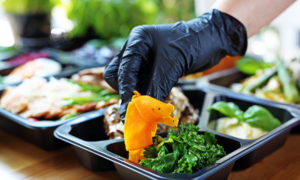When it comes time to reopen your restaurant or store, it probably won’t look like business as usual. The pandemic has prompted business owners to put some safety precautions in place to prevent the spread of disease. So even though doors are starting to open, practices like stringent sanitation and social distancing aren’t going anywhere.
To help retail and dining facilities prepare to welcome guests, we’ve put together some tips for keeping safety and social distancing top of mind.
Space out staff and guests
Maintaining six feet of distance between employees and visitors might prove challenging, especially in small businesses. To do so, many stores and restaurants will have have to implement new policies, set restrictions, and change up their floor layouts.
For example, to prevent face-to-face interactions as guests come and go, businesses may need to assign separate entrances and exits. Restaurants may have to reduce their max capacity, rethink their seating areas to keep visitors safely spread out, and temporarily discontinue things like salad bars and self-service stations.
The same principle applies to stores, too — businesses may have to set restrictions for areas like fitting rooms, pickup counters, and checkout lines to ensure guests aren’t coming into close contact with each other. They may also consider limiting store hours, requiring scheduled appointments or reservations, and staggering visitor entry. All these measures help businesses sufficiently clean between visits and require fewer employees per shift.
Speaking of employees, they’ll also have to abide by social distancing guidelines — whether it’s limiting how many staff members can be in common areas (e.g. break rooms) simultaneously, reducing the number of employees on each shift, or spacing out the desks and standing areas where they work.
Adopt contactless ways to order and pay
Reusable menus and cash payments aren’t coming back in style any time soon. Thankfully, technology offers retailers and restaurants a safer way to operate.
Restaurants can communicate with customers and accept reservations via a website, mobile app, phone call, or text. So guests can wait in their cars until their tables are ready, and even place their orders before they’re seated. They won’t have to wait in line and will be able to spend less time inside the restaurant.
Similarly, retail stores can allow visitors to schedule visits online and, if they’re waiting in a queue, receive text notifications about when they can enter the store.
Touchless payments are also likely to gain popularity. Mobile pay options and QR codes help employees and customers avoid touching kiosks and card readers.
Promote pickups, dropoffs, and deliveries
For the best contactless shopping and dining experiences, restaurants should continue to encourage pickups and deliveries. And stores should consider using BOPIS for product purchases and dropoffs for services (e.g. repairs, cleaning, pet grooming, etc.).
It’s important to designate zones for pickups and dropoffs to help customers and delivery drivers with social distancing. They should know where to go before they get there, as well as any rules they should follow in the process, such as what entrance/exit to use and if they’re required to wear a mask.
Smart package lockers take contactless delivery a step further. Transferring items through the lockers eliminates the need for person-to-person contact. Customers simply get an email or text notification when their orders are ready for pickup.
Lockers can also be installed outside the business to enable customers to retrieve their orders without entering the store or restaurant. And temperature-sensitive items can be safely held in temperature-controlled, refrigerated, or frozen lockers to prevent spoilage.
Clearly communicate new procedures
Whatever your new policies and practices, both customers and employees should know their role in supporting them.
Email and social media messages, signage, and in-store audio messages are all great contactless ways to inform and remind guests of social distancing expectations. There may also be a need for floor markers and physical barriers to encourage everyone to stand six-feet apart.
If you’re interested in learning how smart package lockers can help businesses safety reopen in these challenging times, contact us today.




